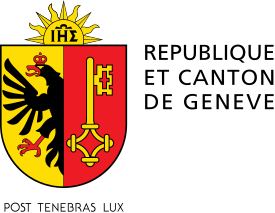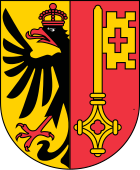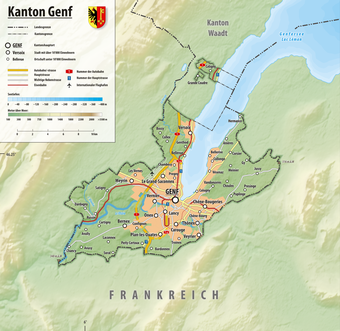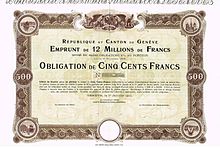Canton of Geneva
|
Republic and Canton of Geneva République et Canton de Genève |
|
|---|---|
| coat of arms | |
| Canton of the Swiss Confederation | |
| Abbreviation / license plate : | GE |
| Official language : | French |
| Main town : | Geneva |
| Accession to the federal government : | 1815 |
| Area : | 282.49 km² |
| Height range : | 331-517 m above sea level M. |
| Website: | www.ge.ch |
| population | |
| Residents: | 499,480 (December 31, 2018) |
| Population density : | 1768 inhabitants per km² |
|
Proportion of foreigners : (residents without citizenship ) |
40.7% (December 31, 2015) |
| Unemployment rate : | 5.7% (December 31, 2015) |
| Location of the canton in Switzerland | |
| Map of the canton | |
| Municipalities of the canton | |

Coordinates: 46 ° 13 ' N , 6 ° 10' E ; CH1903: 501800 / 119304
Geneva ( Swiss German Gämf / Gänf , French Genève [ ʒənɛv, ʒnɛv ], Franco-Provençal Zeneva [ ðəˈnɛva, ˈzɛnəva ], Italian Ginevra , Romansh ), officially French. République et Canton de Genève (Republic and Canton of Geneva), is a canton of Switzerland . It lies in the Francophone Romandie and belongs to the metropolitan area of Geneva-Lausanne . The capital is the city of the same name, Geneva .
geography
The canton of Geneva forms the south-western tip of Switzerland. It is located in Romandy (French-speaking Switzerland) is almost completely surrounded by French territory: its border with France - and its departments of Ain and Haute-Savoie - 103, which the Swiss canton of Vaud contrast, only 4.5 kilometers long.
The canton encloses the southwestern end of Lake Geneva , at the outflow of the Rhone towards the Mediterranean. The second important river is the Arve , which , coming from Chamonix , joins the Rhone in Geneva. The canton is located in the “Geneva Basin” (“cuvette genevoise”) between the four highest peaks of the Jura mountain range and the French mountains Vuache , Salève and Voirons . The landscape is hilly. The highest point ( 516 m above sea level ) is the boundary stone No. 141 near Les Arales near the hamlet of La Monniaz in the municipality of Jussy , the lowest point ( 340 m above sea level ) is also the westernmost point in Switzerland and is adjacent the Rhone at Chancy .
The political municipality of Céligny forms two exclaves of the canton of Geneva in the canton of Vaud on the right bank of Lake Geneva.
population
As of December 31, 2018, the population of the Canton of Geneva was 499,480. The population density of 1768 inhabitants per square kilometer is well above the Swiss average (207 inhabitants per square kilometer). The proportion of foreigners (registered residents without Swiss citizenship ) was 40.7 percent on December 31, 2015, while 24.6 percent were registered nationwide. As of December 31, 2015, the unemployment rate was 5.7 percent compared to 3.7 percent at the federal level.
languages
The official language is French . The sign language is recognized ( Art. 16 Geneva Constitution).
The original language of the region, Franco-Provençal , was superseded by French in the late Middle Ages at the level of the chancellery, but remained on the dialectal level, especially in the Savoyard communities up to 1815, until the 20th century. Today the Geneva patois is extinct.
81 percent of the canton's population cite French , 11 percent English , 10 percent Portuguese , 8 percent Spanish , 7 percent Italian and 5 percent German as their main language (s). (Due to multiple answers, the total is not 100 percent.)
Religions - denominations
The areas that belonged to Geneva before 1815 are traditionally reformed , the formerly French and Savoyard regions affiliated to the Congress of Vienna are traditionally Catholic . As a result of strong immigration from Swiss mountain regions and from southern Europe, the Catholic population has increased sharply. State and church have been separated since 1907, following the French model.
According to a nationwide survey by the Federal Statistical Office (FSO) from 2014 on the subject of religion, 43 percent of the residents of the canton of Geneva describe themselves as Catholic , 10 percent as Reformed and 27 percent as non-denominational . The remaining 20 percent are mostly followers of other Christian denominations (including Evangelicals ) and Muslims . Almost half (49 percent) of the canton's population describe themselves as spiritual and only a good third (35 percent) as religious. 44 percent of the population believe in life after death , 30 percent do not believe in it and a further 26 percent are undecided or have no answer.
Constitution and Politics
The current cantonal constitution was adopted in a referendum on October 14, 2012 (54.1 percent yes votes) and came into force on June 1, 2013. It replaced the previous constitution, which was formally revised in 1847 but fundamentally revised in 1958.
Political life in Geneva is characterized by - by Swiss standards - particularly fierce conflicts, especially between the largely left-wing city government and the largely bourgeois cantonal government. The term geneva was coined for the regular conflicts and scandals .
Direct democratic people's rights
3 percent of Geneva voters can propose the enactment, amendment or repeal of a law themselves within four months by means of a popular initiative ; a partial or total revision of the constitution requires the signatures of 4 percent of the electorate.
Constitutional amendments are subject to the compulsory referendum and must therefore be submitted to the referendum .
Likewise, 3 percent of the electorate can use the optional referendum to demand that a law passed by the Grand Council or resolutions by the Grand Council that result in significant financial expenditures be submitted to a referendum. Laws that provide for a new tax or an amendment to a previous tax, as well as laws that affect tenancy law, require the signature of only 500 voters. The Grand Council can also submit laws to a referendum on its own initiative.
For popular initiatives and referendums at the municipal level, support from 20 percent in municipalities with up to 5,000 voters, support from 10 percent in municipalities with 5,000 to 30,000 voters and support from 5 percent of the voters in municipalities with more residents who are entitled to vote.
legislative branch
The cantonal parliament , the Grand Conseil, has 100 members (grand councils). They are elected by the people who are entitled to vote and vote in a single constituency according to proportional representation for a term of five years. There is a 7% hurdle.
| Political party | percent | Seats | Distribution of seats | Share of voters in percent | |
|---|---|---|---|---|---|
| FDP.The Liberals (FDP) | 25.21 | 28 |
Geneva Grand Council elections on April 15, 2018
Turnout: 38.77%
% 30th 20th 10
0
25.21
15.28
13.16
10.71
9.43
7.83
7.32
11.08
Gains and losses
|
||
| Social Democratic Party of Switzerland (SP) | 15.28 | 17th | |||
| Green Party of Switzerland (GPS) | 13.16 | 15th | |||
| Christian Democratic People's Party (CVP) | 10.71 | 12 | |||
| Mouvement citoyens genevois (MCG) | 9.43 | 11 | |||
| Ensemble à Gauche (EAG) | 7.83 | 9 | |||
| Swiss People's Party (SVP) | 7.32 | 8th | |||
| other parties | 11.08 | - |
executive
The cantonal government , the Council of State (Conseil d'Etat), consists of seven members (Councils of State). The councilors of state are elected by the people according to the majority vote for a fixed term of five years, with the first ballot taking place at the same time as the elections to the Grand Council. The State Council elects its President from among its members for the entire five-year term of office.
The Councilors elected on April 15, 2018 (first ballot) and May 6, 2018 (second ballot) are:
| State Council | Political party | Department (in French) |
|---|---|---|
| Antonio Hodgers President | GPS | Département du territoire (DT) |
| Thierry Apothéloz | SP | Département de la cohésion sociale (DCS) |
| Serge Dal Busco | CVP | Département des infrastructures (DI) |
| Anne Emery-Torracinta | SP | Département de l'instruction publique, de la formation et de la jeunesse (DIP) |
| Nathalie Fontanet | FDP | Département des finances et des ressources humaines (DF) |
| Pierre Maudet | - * | Economic département du développement (DDE) |
| Mauro Poggia | MCG | Département de la securité, de l'emploi et de la santé (DSES) |
* independent, previously FDP
Judiciary
The organization of the courts is the subject of the Geneva Courts Constitution Act of 2010. The courts of first instance are the civil court (Tribunal civil) and the criminal court (Tribunal pénal), both of which are divided into several sections. The court of second instance in civil and criminal matters is the Cour de justice , which is divided into several departments . There are also special courts such as the juvenile court (Tribunal des mineurs), the court in child and adult protection matters (Tribunal de protection de l'adulte et de l'enfant) - whose judges also serve as justice of the peace (Juges de la paix) - and that commercial arbitration tribunal (Juges prud'hommes) . The previous jury court (Cour d'assises) became obsolete in 2011 with the entry into force of the Swiss Code of Criminal Procedure, which no longer provides for trials based on the principle of immediacy.
The constitutional jurisdiction is the Constitutional Court (Cour constitutionnelle) exercised checks the on demand compliance cantonal decrees as parent law, disputes dealt with the exercise of cantonal and municipal political rights to and conflicts between state powers (autorités) decides.
Administrative disputes are judged by the Administrative Court of First Instance (Tribunal administratif de première instance) and the Administrative Court (Cour de droit public), which forms a division of the Cour de justice .
Since 2005/2006, the canton of Geneva has had an independent audit office (Cour des comptes), based on the French model , whose six members control public finances.
The Geneva judges of ordinary jurisdiction, as well as those of the Court of Auditors, are elected by the people for a six-year term according to the majority vote. The judges of the special courts are chosen by the Grand Council. Supervision of the courts is the responsibility of the Council of Judges (Conseil supérieur de la magistrature) , which consists of seven to nine members and whose composition and election are determined by law.
Administrative division
Political communities
The 45 municipalities (communes) are autonomous in accordance with the Geneva Constitution and laws, although their independence is quite limited compared to the municipalities in German-speaking Switzerland .
Each municipality has a municipal council, the (Conseil municipal), as the legislature and a Conseil administratif as the executive. Instead of the latter, small parishes have only one mayor (maire) who is supported by two adjoints . Both councils are elected by the people for a term of five years each.
Of the total of 45 political municipalities, those twelve are listed below that had more than 10,000 inhabitants as of December 31, 2018:
| Political community | Residents | Proportion of foreigners in percent |
|---|---|---|
| Geneva , capital | 201,818 | 47.8 |
| Vernier | 34,791 | 44.3 |
| Lancy | 32,851 | 35.4 |
| Meyrin | 25'255 | 43.7 |
| Carouge | 22,458 | 37.4 |
| Onex | 18,964 | 36.3 |
| Thônex | 14'122 | 34.7 |
| Versoix | 13'432 | 41.8 |
| Le Grand-Saconnex | 12,167 | 41.7 |
| Chêne-Bougeries | 12'215 | 34.0 |
| Veyrier | 11,612 | 27.5 |
| Plan-les-Ouates | 10,657 | 22.3 |
Districts
The canton of Geneva is not divided into districts. However, the Federal Statistical Office (FSO) lists the entire canton as one district under FSO no. 2500.
economy
Geneva is the seat of numerous international authorities, an important banking and trading city, has diverse industries and is a conference center. Tourism is also important.
The most important power plants in the canton are the Barrage de Verbois (466 gigawatt hours per year) and Chancy-Pougny (210 GWh / year) run-of-river power plants , the Les Cheneviers waste incineration plant (125 GWh / year) and the Barrage du Seujet run-of-river power plant (20 GWh / year) . Services Industriels de Genève are cantonal infrastructure companies .
traffic
The city and canton are both nationally and internationally accessible: Switzerland's second largest airport ( Genève-Cointrin ), connection to the French high-speed rail network ( TGV ), Lyon - Bern motorway . Regional public transport, which has been neglected for a long time, is currently being strongly promoted again through the renewed expansion of the previously greatly reduced tram network. In 2019, the degree of motorization (passenger cars per 1000 inhabitants) was 541.
history
From city-state to Swiss canton 1798–1815
The canton of Geneva was formed in 1815 from the city republic of Geneva, its subject areas and the French and Savoyard territories awarded to it by the Congress of Vienna (e.g. the city of Carouge ). (→ See History of Geneva ). On September 12, 1814, the Federal Diet officially approved the admission of Geneva as the 22nd canton into the Confederation. The Unification Treaty was signed on May 19, 1815. The cession of the territories of France and the Kingdom of Sardinia was regulated in the Second Peace of Paris in 1815 and in the Treaty of Turin in 1816.
The aristocratic regime lasted until the liberal revolution of October 7, 1846. In the following year, 1847, Geneva adopted a new cantonal constitution and, in 1848, approved the new federal constitution of the Swiss Confederation . Since then it has been one of the socially liberal cantons in Switzerland.
See also
literature
- Collective of authors: Histoire de Genève. 3 volumes. Editions Alphil, Neuchâtel 2014.
- Martine Piguet, Jean Terrier, editor, Liliane Mottu-Weber, Charles Heimberg, Irène Herrmann: Geneva (Canton). In: Historical Lexicon of Switzerland .
Web links
|
Further content in the sister projects of Wikipedia:
|
||
|
|
Commons | - multimedia content |
|
|
Wiktionary | - Dictionary entries |
|
|
Wikisource | - Sources and full texts |
|
|
Wikinews | - News |
|
|
Wikivoyage | - Travel Guide |
Individual evidence
- ↑ Balance of the permanent resident population by canton, definitive annual results, 2018. Federal Statistical Office (FSO), August 27, 2019, accessed on September 18, 2019 (definitive annual results).
- ↑ Structure of the permanent resident population by cantons. Federal Statistical Office (FSO), August 26, 2016, accessed on May 31, 2017 .
- ^ The situation on the job market in December 2015. (PDF; 807 kB) State Secretariat for Economic Affairs (SECO), January 8, 2016, p. 9 , archived from the original on January 12, 2016 ; accessed on January 13, 2016 .
- ↑ Balance of the permanent resident population by canton, definitive annual results, 2018. Federal Statistical Office (FSO), August 27, 2019, accessed on September 18, 2019 (definitive annual results).
- ↑ Structure of the permanent resident population by cantons. Federal Statistical Office (FSO), August 26, 2016, accessed on May 31, 2017 .
- ^ The situation on the job market in December 2015. (PDF; 807 kB) State Secretariat for Economic Affairs (SECO), January 8, 2016, p. 9 , archived from the original on January 12, 2016 ; accessed on January 13, 2016 .
- ^ Wulf Müller: On the history of the language of the Suisse romande. In: Swiss German Dictionary. Swiss Idioticon. Report on the year 2002. [Zurich] 2003, pp. 11–24.
- ↑ Population résidante selon l'origine et la ou les langue (s) principale (s) de 2012 à 2014. (XLS; 82 kB) Office cantonal de la statistique (OCSTAT), April 11, 2016, accessed on January 17, 2016 .
- ^ Religion et spiritualité à Genève en 2014 (PDF; 1713 kB) Office cantonal de la statistique (OCSTAT), December 12, 2016, accessed on January 17, 2016 .
- ^ Constitution de la République et canton de Genève. German translation: Constitution of the Republic and the Canton of Geneva .
- ↑ Matthias Chapman: “Geneva staggers from one nonsense to the next” , Der Bund, January 23, 2012
- ↑ Election du Grand Conseil du 15 avril 2018 (election of the Grand Council on April 15, 2018). Republic and Canton of Geneva. Retrieved April 15, 2018.
- ↑ Élection du Conseil d'Etat (premier tour) on 15 avril 2018. Accessed 9 October 2019 .
- ^ Second tour de l'élection du Conseil d'Etat 2018. Accessed October 9, 2019 .
- ^ Loi sur l'organization judiciaire (Law on judicial organization). From September 26, 2010. Republic and Canton of Geneva. Retrieved December 27, 2013.
- ↑ Permanent and non-permanent resident population by year, canton, district, municipality, population type and gender (permanent resident population). In: bfs. admin.ch . Federal Statistical Office (FSO), August 31, 2019, accessed on December 22, 2019 .
- ↑ Road vehicles - inventory, degree of motorization. In: Federal Statistical Office. 2020, accessed April 25, 2020 .






